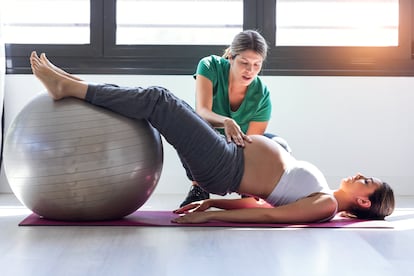How to exercise during pregnancy safely for both mother and baby
Recent research shows that doing sports while following the instructions of specialists reduces the risk of complications during pregnancy, in addition to facilitating labor and recovery


Everybody is used to overprotecting pregnant women, urging them to curb their activity and rest as much as they can. However, for approximately three decades now, scientific literature has been stating precisely the opposite. Having an active life is as important during pregnancy as having a healthy diet or going to all the routine check-ups, explains gynecologist Carmen Gutiérrez.
Despite the advice of specialists, less than 20% of women globally meet the WHO recommendations of practicing 150 minutes of physical exercise a week, according to the Clinical Practice Guide on Physical Activity During Pregnancy published by the Polytechnic University of Madrid (UPM), which explains the benefits of staying active during those nine months, and how to do it safely for both mother and baby.
Throughout 2023, UPM researchers published several studies showing the advantages that playing sports has for pregnant women. Some of the insights provided by these articles are that future mothers who engage in some type of physical activity reduce the risk of gaining excessive weight and suffering from diabetes during pregnancy by between 32% and 38%, respectively. It also reduces the possibility of having to resort to C-section by 13% and instrumental delivery by 16%. It is even associated with a reduction of about one hour of dilation prior to labor.
Controlling the weight that the mother gains during pregnancy is one of the most important factors. Cristina Silva, doctor in physical activity and sports sciences and one of the authors of the articles, explains that this aspect prevents macrosomia (when the baby weighs more than 4 kilos, or 8 pounds, 13 ounces), which is associated with obesity and a higher number of neonatal ICU admissions. Regarding mental health, it reduces anxiety, stress and pre- and postpartum depression. “Women who are physically active during pregnancy are better at handling the muscular, respiratory and mechanical tasks imposed by the birth process in each of its stages,” explains Rubén Barakat, teacher of physical and sports education and one of the authors of the UPM studies.
Exercising the pelvic floor muscles is also important. Although the scientific evidence on this is still scarce, it has been shown that working it for three or four days a week reduces postpartum urinary incontinence, says Gutiérrez. Both she and Francisca Molina, vice president of the Spanish Society of Gynecology and Obstetrics (SEGO), agree that women who remain active during pregnancy have a faster postpartum recovery than those who lead a sedentary life.
If the recommended 150 minutes per week are divided into six days, that is 25 minutes of physical exercise per day, points out Silva. “The important thing is to establish the habit from the beginning, and make it regular,” she stresses, and adds that individualization is essential to achieve it; if they like the activities they practice, they will remain motivated more easily.
Adapted activity
The recommendations are not too specific; during those nine months almost any activity can be carried out as long as it is adapted to each person’s individual circumstances. For example, a woman who practices cycling should replace it with a stationary bicycle during those months in order to avoid the risk of falls. Cristina Díaz del Campo, member of the Spanish Association of Physiotherapists in Women’s Health and Pelvic Health (AEF-SAMU), says that the most advisable and safe things to do are walking, practicing Pilates or yoga for pregnant women (supervised by a physical therapist) and swimming. Swimming underwater, however, is not recommended, due to the pressure changes, as well as rough sports such as soccer, basketball, boxing or skiing.
Women who train in the gym should adapt the postures of their exercises, but only if they have experience and know how to perform all the necessary techniques well, warns Silva. They should avoid prone positions and limit the time they spend on their back to two to three minutes per activity. For the latter, they can adapt their posture and use a gymnastic ball so that they are not completely lying down and the practice is safer.
In addition to being adapted, it is important that any physical activity that a pregnant woman does is guided. All experts agree that it is best to have a specialist (a personal trainer or a pelvic floor physical therapist); however, individual attention tends to be expensive, so that option is not available to everyone. Group classes, on the other hand, are more affordable.
To work with pregnant women, says Silva, exercise sessions must include several components: an aerobic part that is not strenuous, muscle strengthening (especially in the upper and lumbar areas, for the care that the baby will require), balance and coordination to avoid falls as the body changes, pelvic floor work – which is essential – and, finally, relaxation and returning to calm.
Pelvic floor and hip flexibility
The three key points of perinatal physiotherapy are: preparation of the pelvic floor, physical exercise and providing strategies so that the pregnant woman and her companion can face the labor, explains Díaz del Campo. In addition to exercises to tone and get the future mother in shape, aspects such as the flexibility of the hips and pelvis are also worked on. These are individualized and supervised exercises in which internal and external hip rotation movements are performed, which will help the baby fit better in the birth canal.
Díaz del Campo warns that before starting to work the pelvic floor muscles it is necessary for a physical therapist specialized in women’s health to make a prior assessment of their condition. Perinatal physiotherapy also recommends and teaches how to do perineal massages, so that women can do it at home; it is advisable to do it from week 32 of gestation, as it can prevent the tearing of the perineal tissue.
“Healthcare providers are a good platform to raise awareness among women about the importance of exercising during pregnancy,” states Silva. However, “their message may be limited by the lack of public programs,” laments Barakat. This situation often leaves women with fewer resources behind, adds the specialist, who calls for a greater investment in this area. “The existing scientific evidence should be used by institutions to design ambitious and extensive physical activity programs for pregnant women.”
Sign up for our weekly newsletter to get more English-language news coverage from EL PAÍS USA Edition
Tu suscripción se está usando en otro dispositivo
¿Quieres añadir otro usuario a tu suscripción?
Si continúas leyendo en este dispositivo, no se podrá leer en el otro.
FlechaTu suscripción se está usando en otro dispositivo y solo puedes acceder a EL PAÍS desde un dispositivo a la vez.
Si quieres compartir tu cuenta, cambia tu suscripción a la modalidad Premium, así podrás añadir otro usuario. Cada uno accederá con su propia cuenta de email, lo que os permitirá personalizar vuestra experiencia en EL PAÍS.
¿Tienes una suscripción de empresa? Accede aquí para contratar más cuentas.
En el caso de no saber quién está usando tu cuenta, te recomendamos cambiar tu contraseña aquí.
Si decides continuar compartiendo tu cuenta, este mensaje se mostrará en tu dispositivo y en el de la otra persona que está usando tu cuenta de forma indefinida, afectando a tu experiencia de lectura. Puedes consultar aquí los términos y condiciones de la suscripción digital.
More information
Últimas noticias
Raúl Rocha, from jet-setting with Miss Universe to arms trafficking and fuel theft
80,000 barrels of Mexican oil sent to Cuba: Havana drawn into the US–Mexico clash
Human rights activists, opposition members, and a minor: Maduro’s other political prisoners
Israel sparks a civil war within the MAGA movement
Most viewed
- Reinhard Genzel, Nobel laureate in physics: ‘One-minute videos will never give you the truth’
- Pablo Escobar’s hippos: A serious environmental problem, 40 years on
- Charles Dubouloz, mountaineering star, retires at 36 with a farewell tour inspired by Walter Bonatti
- Why we lost the habit of sleeping in two segments and how that changed our sense of time
- The Florida Keys tourist paradise is besieged by immigration agents: ‘We’ve never seen anything like this’










































